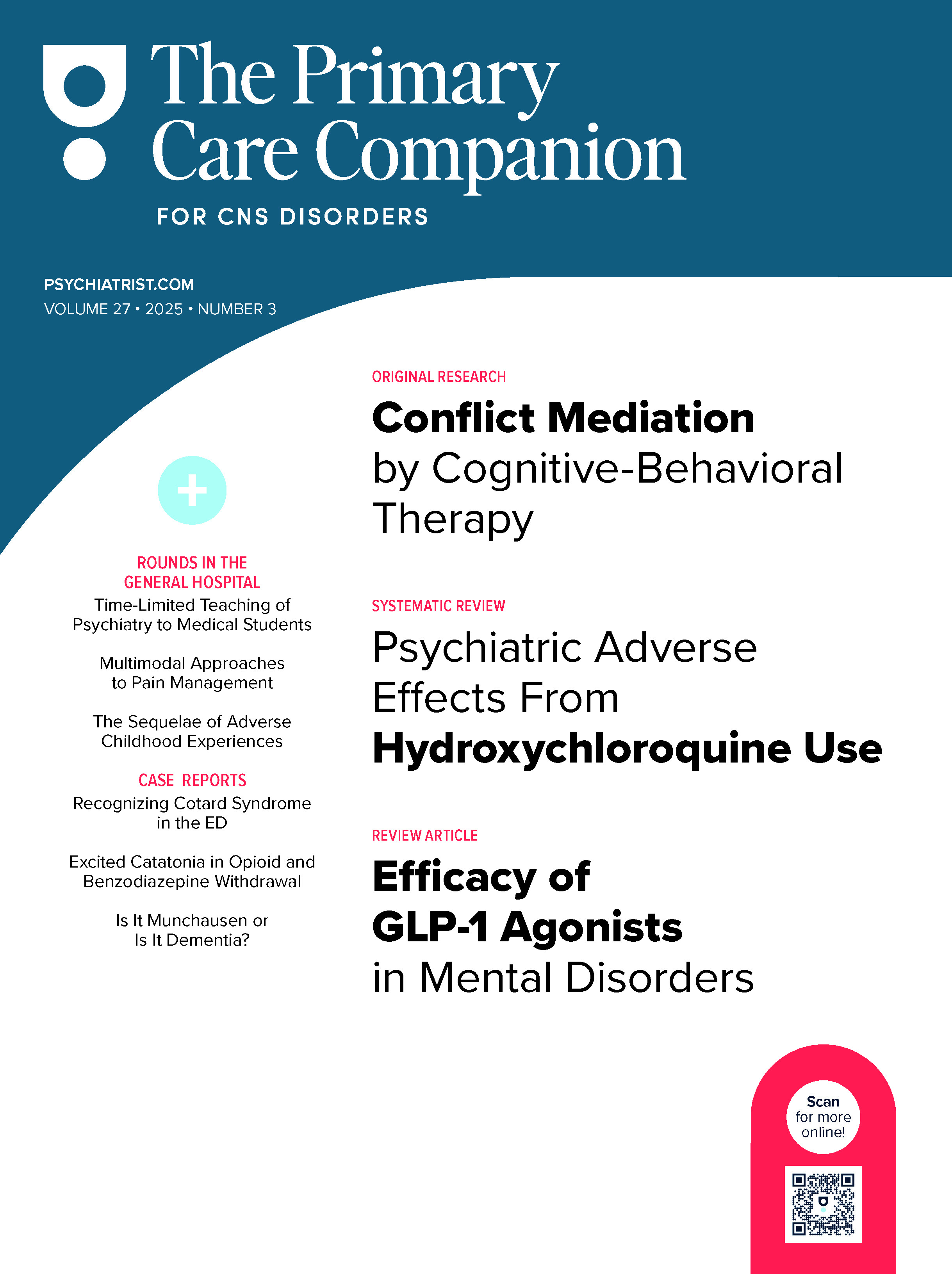Uremia develops when decreased renal excretion leads to an accumulation of retained waste solutes in the blood.1 Common symptoms of uremia include fatigue, decreased mental acuity, and nausea.2 Visual hallucinations in the context of delirium secondary to uremia are also reported.3
A visual hallucination is defined as the perception of an object or event in the absence of an external stimulus.4 Bilateral visual hallucinations have many etiologies, including uremia; however, there are far fewer for unilateral visual hallucinations (ie, occipital epilepsy and retinal migraines).5,6 Although most often symmetric and asymptomatic, diabetic retinopathy can be asymmetric and present with unilateral visual field changes.7 We report a case of a uremic patient who had 2 episodes of unilateral visual hallucinations, which resolved both times after hemodialysis. During the initial unilateral visual hallucinations, the patient was diagnosed with a migraine based on history alone by an outpatient provider prior to presenting to our institution with significant distress and suicidal ideation due to persistent unilateral visual hallucinations.
Case Report
A male patient in his late 40s with type 1 diabetes, chronic kidney disease stage 3, and no previous history of mental illness or hallucinations presented with suicidal ideation. The patient reported feeling hopeless due to persistent unilateral visual hallucinations in his right eye for the past 1 to 2 months. The patient reported seeing everything through a “red lens” with bugs, described as multiple tiny moving dots, constantly flying around through his right eye. Meanwhile, his vision through his left eye was normal. The intensity of the red lens was dampened by wearing sunglasses but the bugs persisted. Closing or covering his right eye relieved his symptoms. He initially saw an outpatient provider and was diagnosed with a migraine based on history alone. He denied any nausea, vomiting, light/ sound sensitivity, or headache prior to or during the hallucinations. Upon admission, he was found to have acute on-chronic kidney disease (blood urea nitrogen [BUN]=165 mg/dL, creatinine=19.3 mg/dL). Aside from unilateral visual hallucinations, the patient had an otherwise intact neurological examination. He was started on hemodialysis, and his visual hallucinations promptly resolved. He was discharged improved with scheduled routine hemodialysis.
A year later, the patient presented with the same right-sided visual hallucinations after missing sessions of scheduled hemodialysis (BUN = 140 mg/dL, creatinine = 16.8 mg/dL). His symptoms resolved after hemodialysis just as they did during his previous admission. He again remained neurologically intact aside from the hallucinations he reported.
Discussion
Although uremia is known to cause visual hallucinations, they are usually bilateral. However, given that the patient’s unilateral visual hallucinations resolved twice with hemodialysis, we suspect uremia was the most likely underlying cause. The patient’s presentation was not consistent with any other causes of unilateral visual hallucinations such as retinal migraine, occipital epilepsy, or migraine with aura.5,6,8 Furthermore, new-onset migraine in this case is less likely, as migraines are more common among females and people aged 18–44 years.9 The patient’s diabetic retinopathy screening status was unclear prior to admission. However, since the symptoms resolved completely after hemodialysis, diabetic retinopathy is an unlikely etiology.
Although the patient initially was diagnosed with a migraine based on history alone, the International Classification of Headache Disorders suggests that patients with new-onset aura symptoms over the age of 40 years should be evaluated for other causes such as transient ischemic attacks.8 Patients with diabetes, such as our patient, have increased risk of various medical complications. Thus, a basic workup, such as a metabolic profile and imaging, may have been warranted in this case to address his symptoms in a timelier manner.
Article Information
Published Online: November 5, 2024. https://doi.org/10.4088/PCC.24cr03791
© 2024 Physicians Postgraduate Press, Inc.
Prim Care Companion CNS Disord 2024;26(6):24cr03791
Submitted: June 15, 2024; accepted August 12, 2024.
To Cite: Huo T, Kanja K, Kiyokawa M. Misdiagnosis of unilateral visual hallucination from uremia leading to suicidal ideation. Prim Care Companion CNS Disord. 2024;26(6):24cr03791.
Author Affiliations: Department of Psychiatry, John A. Burns School of Medicine, University of Hawaii, Honolulu, Hawaii (Huo, Kanja, Kiyokawa); Department of Medicine, John A. Burns School of Medicine, University of Hawaii, Honolulu, Hawaii (Kiyokawa).
Corresponding Author: Miki Kiyokawa, MD, Department of Psychiatry, John A. Burns School of Medicine, University of Hawaii, HI 96813 ([email protected]).
Relevant Financial Relationships: None.
Funding/Support: None.
Patient Consent: Consent was received from the patient to publish the case report, and information has been de identified to protect anonymity.
References (9)

- Meyer TW, Hostetter TH. Approaches to uremia. J Am Soc Nephrol. 2014;25(10):2151–2158. PubMed CrossRef
- Foris LA, Bashir K. Uremia. Accessed January 13, 2019. https://www.ncbi.nlm.nih.gov/books/NBK441859/
- Moreira JM, da Matta SM, Melo e Kummer A, et al. Neuropsychiatric disorders and renal diseases: an update. Braz J Nephrol. 2014;36(3):396–400. PubMed CrossRef
- Teeple RC, Caplan JP, Stern TA. Visual hallucinations: differential diagnosis and treatment. Prim Care companion J Clin Psychiatry. 2009;11(1):26–32. PubMed CrossRef
- Panayiotopoulos CP. Elementary visual hallucinations, blindness, and headache in idiopathic occipital epilepsy: differentiation from migraine. J Neurol Neurosurg Psychiatry. 1999;66(4):536–540. PubMed CrossRef
- Chong YJ, Mollan SP, Logeswaran A, et al. Current perspective on retinal migraine. Vision (Basel). 2021;5(3):38. PubMed
- Azad R, Sinha S, Nishant P. Asymmetric diabetic retinopathy. Indian J Ophthalmol. 2021;69(11):3026–3034. PubMed CrossRef
- Headache Classification Committee of the International Headache Society (IHS) The International Classification of Headache Disorders, 3rd edition. Cephalalgia. 2018;38(1):1–211. PubMed CrossRef
- Peters GL. Migraine overview and summary of current and emerging treatment options. Am J Manag Care. 2019;25(2 suppl):S23–S34. PubMed
Please sign in or purchase this PDF for $40.




